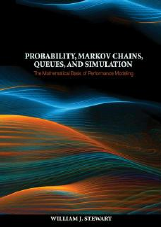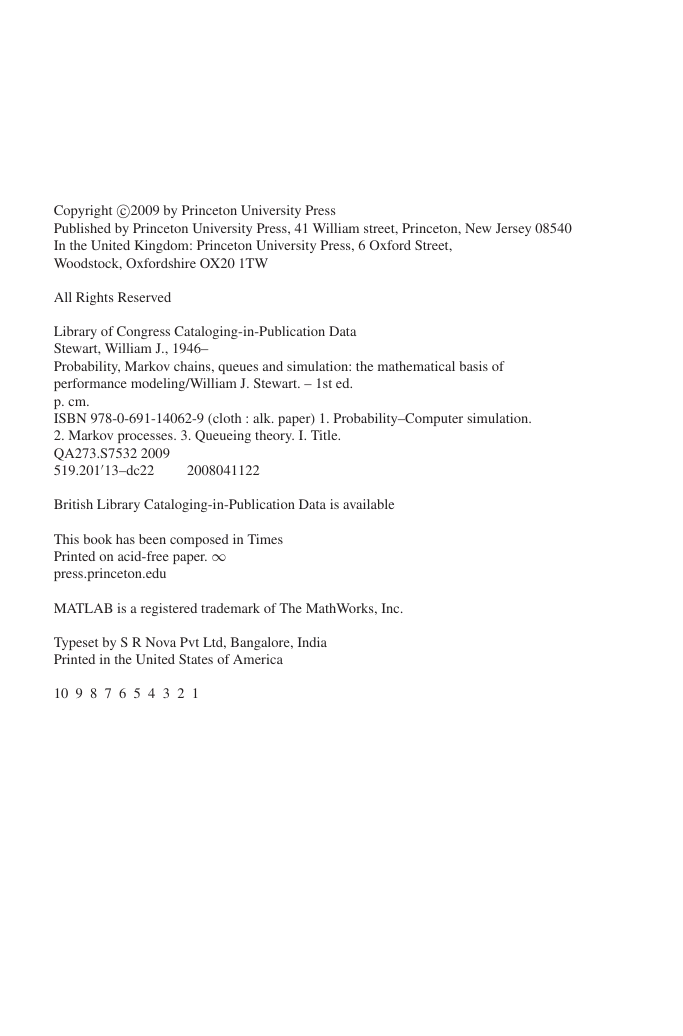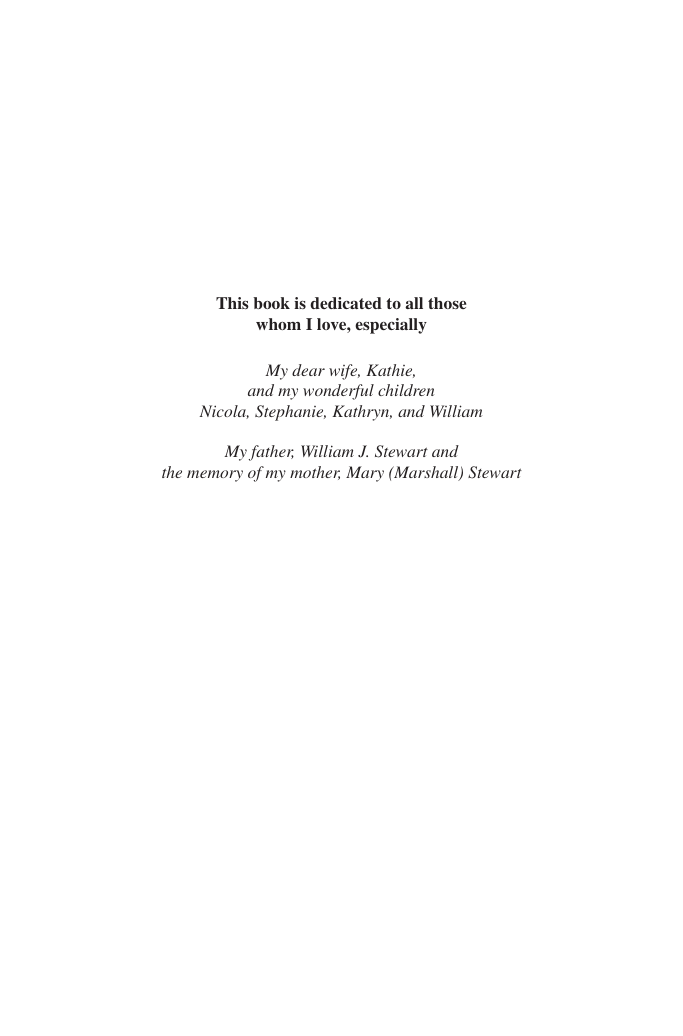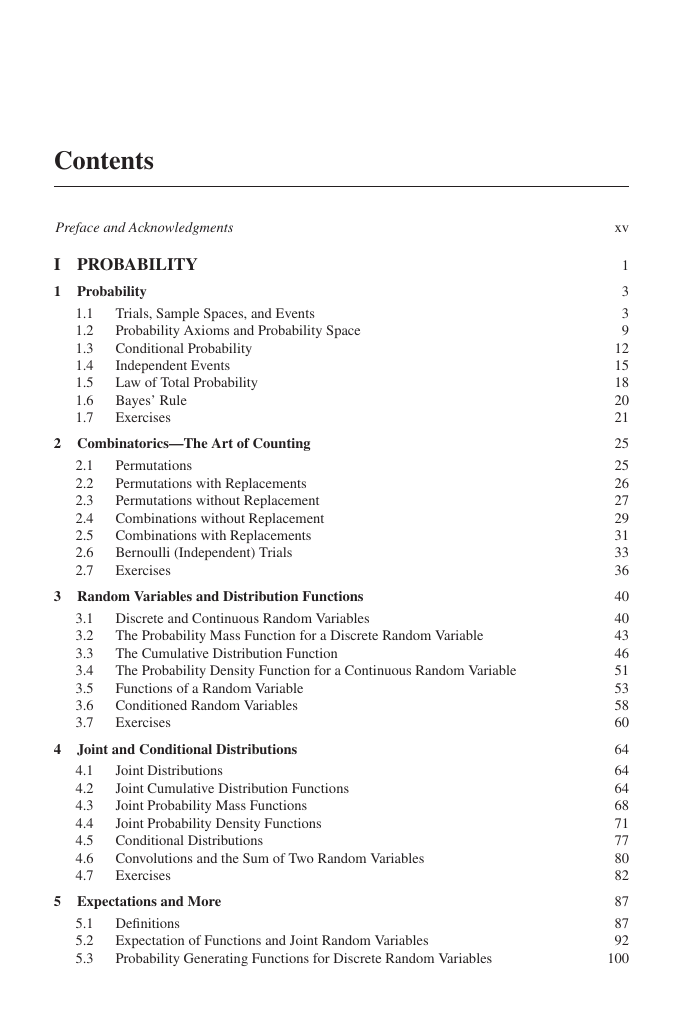Cover
Contents
Preface and Acknowledgments
I: PROBABILITY
1 Probability
1.1 Trials, Sample Spaces, and Events
1.2 Probability Axioms and Probability Space
1.3 Conditional Probability
1.4 Independent Events
1.5 Law of Total Probability
1.6 Bayes' Rule
1.7 Exercises
2 Combinatorics—The Art of Counting
2.1 Permutations
2.2 Permutations with Replacements
2.3 Permutations without Replacement
2.4 Combinations without Replacement
2.5 Combinations with Replacements
2.6 Bernoulli (Independent) Trials
2.7 Exercises
3 Random Variables and Distribution Functions
3.1 Discrete and Continuous Random Variables
3.2 The Probability Mass Function for a Discrete Random Variable
3.3 The Cumulative Distribution Function
3.4 The Probability Density Function for a Continuous Random Variable
3.5 Functions of a Random Variable
3.6 Conditioned Random Variables
3.7 Exercises
4 Joint and Conditional Distributions
4.1 Joint Distributions
4.2 Joint Cumulative Distribution Functions
4.3 Joint Probability Mass Functions
4.4 Joint Probability Density Functions
4.5 Conditional Distributions
4.6 Convolutions and the Sum of Two Random Variables
4.7 Exercises
5 Expectations and More
5.1 Definitions
5.2 Expectation of Functions and Joint Random Variables
5.3 Probability Generating Functions for Discrete Random Variables
5.4 Moment Generating Functions
5.5 Maxima and Minima of Independent Random Variables
5.6 Exercises
6 Discrete Distribution Functions
6.1 The Discrete Uniform Distribution
6.2 The Bernoulli Distribution
6.3 The Binomial Distribution
6.4 Geometric and Negative Binomial Distributions
6.5 The Poisson Distribution
6.6 The Hypergeometric Distribution
6.7 The Multinomial Distribution
6.8 Exercises
7 Continuous Distribution Functions
7.1 The Uniform Distribution
7.2 The Exponential Distribution
7.3 The Normal or Gaussian Distribution
7.4 The Gamma Distribution
7.5 Reliability Modeling and the Weibull Distribution
7.6 Phase-Type Distributions
7.6.1 The Erlang-2 Distribution
7.6.2 The Erlang-r Distribution
7.6.3 The Hypoexponential Distribution
7.6.4 The Hyperexponential Distribution
7.6.5 The Coxian Distribution
7.6.6 General Phase-Type Distributions
7.6.7 Fitting Phase-Type Distributions to Means and Variances
7.7 Exercises
8 Bounds and Limit Theorems
8.1 The Markov Inequality
8.2 The Chebychev Inequality
8.3 The Chernoff Bound
8.4 The Laws of Large Numbers
8.5 The Central Limit Theorem
8.6 Exercises
II: MARKOV CHAINS
9 Discrete- and Continuous-Time Markov Chains
9.1 Stochastic Processes and Markov Chains
9.2 Discrete-Time Markov Chains: Definitions
9.3 The Chapman-Kolmogorov Equations
9.4 Classification of States
9.5 Irreducibility
9.6 The Potential, Fundamental, and Reachability Matrices
9.6.1 Potential and Fundamental Matrices and Mean Time to Absorption
9.6.2 The Reachability Matrix and Absorption Probabilities
9.7 Random Walk Problems
9.8 Probability Distributions
9.9 Reversibility
9.10 Continuous-Time Markov Chains
9.10.1 Transition Probabilities and Transition Rates
9.10.2 The Chapman-Kolmogorov Equations
9.10.3 The Embedded Markov Chain and State Properties
9.10.4 Probability Distributions
9.10.5 Reversibility
9.11 Semi-Markov Processes
9.12 Renewal Processes
9.13 Exercises
10 Numerical Solution of Markov Chains
10.1 Introduction
10.1.1 Setting the Stage
10.1.2 Stochastic Matrices
10.1.3 The Effect of Discretization
10.2 Direct Methods for Stationary Distributions
10.2.1 Iterative versus Direct Solution Methods
10.2.2 Gaussian Elimination and LU Factorizations
10.3 Basic Iterative Methods for Stationary Distributions
10.3.1 The Power Method
10.3.2 The Iterative Methods of Jacobi and Gauss–Seidel
10.3.3 The Method of Successive Overrelaxation
10.3.4 Data Structures for Large Sparse Matrices
10.3.5 Initial Approximations, Normalization, and Convergence
10.4 Block Iterative Methods
10.5 Decomposition and Aggregation Methods
10.6 The Matrix Geometric/Analytic Methods for Structured Markov Chains
10.6.1 The Quasi-Birth-Death Case
10.6.2 Block Lower Hessenberg Markov Chains
10.6.3 Block Upper Hessenberg Markov Chains
10.7 Transient Distributions
10.7.1 Matrix Scaling and Powering Methods for Small State Spaces
10.7.2 The Uniformization Method for Large State Spaces
10.7.3 Ordinary Differential Equation Solvers
10.8 Exercises
III: QUEUEING MODELS
11 Elementary Queueing Theory
11.1 Introduction and Basic Definitions
11.1.1 Arrivals and Service
11.1.2 Scheduling Disciplines
11.1.3 Kendall's Notation
11.1.4 Graphical Representations of Queues
11.1.5 Performance Measures—Measures of Effectiveness
11.1.6 Little's Law
11.2 Birth-Death Processes: The M/M/1 Queue
11.2.1 Description and Steady-State Solution
11.2.2 Performance Measures
11.2.3 Transient Behavior
11.3 General Birth-Death Processes
11.3.1 Derivation of the State Equations
11.3.2 Steady-State Solution
11.4 Multiserver Systems
11.4.1 The M/M/c Queue
11.4.2 The M/M/∞ Queue
11.5 Finite-Capacity Systems—The M/M/1/K Queue
11.6 Multiserver, Finite-Capacity Systems—The M/M/c/K Queue
11.7 Finite-Source Systems—The M/M/c//M Queue
11.8 State-Dependent Service
11.9 Exercises
12 Queues with Phase-Type Laws: Neuts' Matrix-Geometric Method
12.1 The Erlang-r Service Model—The M/E[sub(r)]/1 Queue
12.2 The Erlang-r Arrival Model—The E[sub(r)]/M/1 Queue
12.3 The M/H[sub(2)]/1 and H[sub(2)]/M/1 Queues
12.4 Automating the Analysis of Single-Server Phase-Type Queues
12.5 The H[sub(2)]/E[sub(3)]/1 Queue and General Ph/Ph/1 Queues
12.6 Stability Results for Ph/Ph/1 Queues
12.7 Performance Measures for Ph/Ph/1 Queues
12.8 Matlab code for Ph/Ph/1 Queues
12.9 Exercises
13 The z-Transform Approach to Solving Markovian Queues
13.1 The z-Transform
13.2 The Inversion Process
13.3 Solving Markovian Queues using z-Transforms
13.3.1 The z-Transform Procedure
13.3.2 The M/M/1 Queue Solved using z-Transforms
13.3.3 The M/M/1 Queue with Arrivals in Pairs
13.3.4 The M/E[sub(r)]/1 Queue Solved using z-Transforms
13.3.5 The E[sub(r)]/M/1 Queue Solved using z-Transforms
13.3.6 Bulk Queueing Systems
13.4 Exercises
14 The M/G/1 and G/M/1 Queues
14.1 Introduction to the M/G/1 Queue
14.2 Solution via an Embedded Markov Chain
14.3 Performance Measures for the M/G/1 Queue
14.3.1 The Pollaczek-Khintchine Mean Value Formula
14.3.2 The Pollaczek-Khintchine Transform Equations
14.4 The M/G/1 Residual Time: Remaining Service Time
14.5 The M/G/1 Busy Period
14.6 Priority Scheduling
14.6.1 M/M/1: Priority Queue with Two Customer Classes
14.6.2 M/G/1: Nonpreemptive Priority Scheduling
14.6.3 M/G/1: Preempt-Resume Priority Scheduling
14.6.4 A Conservation Law and SPTF Scheduling
14.7 The M/G/1/K Queue
14.8 The G/M/1 Queue
14.9 The G/M/1/K Queue
14.10 Exercises
15 Queueing Networks
15.1 Introduction
15.1.1 Basic Definitions
15.1.2 The Departure Process—Burke's Theorem
15.1.3 Two M/M/1 Queues in Tandem
15.2 Open Queueing Networks
15.2.1 Feedforward Networks
15.2.2 Jackson Networks
15.2.3 Performance Measures for Jackson Networks
15.3 Closed Queueing Networks
15.3.1 Definitions
15.3.2 Computation of the Normalization Constant: Buzen's Algorithm
15.3.3 Performance Measures
15.4 Mean Value Analysis for Closed Queueing Networks
15.5 The Flow-Equivalent Server Method
15.6 Multiclass Queueing Networks and the BCMP Theorem
15.6.1 Product-Form Queueing Networks
15.6.2 The BCMP Theorem for Open, Closed, and Mixed Queueing Networks
15.7 Java Code
15.8 Exercises
IV: SIMULATION
16 Some Probabilistic and Deterministic Applications of Random Numbers
16.1 Simulating Basic Probability Scenarios
16.2 Simulating Conditional Probabilities, Means, and Variances
16.3 The Computation of Definite Integrals
16.4 Exercises
17 Uniformly Distributed "Random" Numbers
17.1 Linear Recurrence Methods
17.2 Validating Sequences of Random Numbers
17.2.1 The Chi-Square "Goodness-of-Fit" Test
17.2.2 The Kolmogorov-Smirnov Test
17.2.3 "Run" Tests
17.2.4 The "Gap" Test
17.2.5 The "Poker" Test
17.2.6 Statistical Test Suites
17.3 Exercises
18 Nonuniformly Distributed "Random" Numbers
18.1 The Inverse Transformation Method
18.1.1 The Continuous Uniform Distribution
18.1.2 "Wedge-Shaped" Density Functions
18.1.3 "Triangular" Density Functions
18.1.4 The Exponential Distribution
18.1.5 The Bernoulli Distribution
18.1.6 An Arbitrary Discrete Distribution
18.2 Discrete Random Variates by Mimicry
18.2.1 The Binomial Distribution
18.2.2 The Geometric Distribution
18.2.3 The Poisson Distribution
18.3 The Accept-Reject Method
18.3.1 The Lognormal Distribution
18.4 The Composition Method
18.4.1 The Erlang-r Distribution
18.4.2 The Hyperexponential Distribution
18.4.3 Partitioning of the Density Function
18.5 Normally Distributed Random Numbers
18.5.1 Normal Variates via the Central Limit Theorem
18.5.2 Normal Variates via Accept-Reject and Exponential Bounding Function
18.5.3 Normal Variates via Polar Coordinates
18.5.4 Normal Variates via Partitioning of the Density Function
18.6 The Ziggurat Method
18.7 Exercises
19 Implementing Discrete-Event Simulations
19.1 The Structure of a Simulation Model
19.2 Some Common Simulation Examples
19.2.1 Simulating the M/M/1 Queue and Some Extensions
19.2.2 Simulating Closed Networks of Queues
19.2.3 The Machine Repairman Problem
19.2.4 Simulating an Inventory Problem
19.3 Programming Projects
20 Simulation Measurements and Accuracy
20.1 Sampling
20.1.1 Point Estimators
20.1.2 Interval Estimators/Confidence Intervals
20.2 Simulation and the Independence Criteria
20.3 Variance Reduction Methods
20.3.1 Antithetic Variables
20.3.2 Control Variables
20.4 Exercises
Appendix A: The Greek Alphabet
Appendix B: Elements of Linear Algebra
B.1 Vectors and Matrices
B.2 Arithmetic on Matrices
B.3 Vector and Matrix Norms
B.4 Vector Spaces
B.5 Determinants
B.6 Systems of Linear Equations
B.6.1 Gaussian Elimination and LU Decompositions
B.7 Eigenvalues and Eigenvectors
B.8 Eigenproperties of Decomposable, Nearly Decomposable, and Cyclic Stochastic Matrices
B.8.1 Normal Form
B.8.2 Eigenvalues of Decomposable Stochastic Matrices
B.8.3 Eigenvectors of Decomposable Stochastic Matrices
B.8.4 Nearly Decomposable Stochastic Matrices
B.8.5 Cyclic Stochastic Matrices
Bibliography
Index
A
B
C
D
E
F
G
H
I
J
K
L
M
N
O
P
Q
R
S
T
U
V
W
Z
















 2023年江西萍乡中考道德与法治真题及答案.doc
2023年江西萍乡中考道德与法治真题及答案.doc 2012年重庆南川中考生物真题及答案.doc
2012年重庆南川中考生物真题及答案.doc 2013年江西师范大学地理学综合及文艺理论基础考研真题.doc
2013年江西师范大学地理学综合及文艺理论基础考研真题.doc 2020年四川甘孜小升初语文真题及答案I卷.doc
2020年四川甘孜小升初语文真题及答案I卷.doc 2020年注册岩土工程师专业基础考试真题及答案.doc
2020年注册岩土工程师专业基础考试真题及答案.doc 2023-2024学年福建省厦门市九年级上学期数学月考试题及答案.doc
2023-2024学年福建省厦门市九年级上学期数学月考试题及答案.doc 2021-2022学年辽宁省沈阳市大东区九年级上学期语文期末试题及答案.doc
2021-2022学年辽宁省沈阳市大东区九年级上学期语文期末试题及答案.doc 2022-2023学年北京东城区初三第一学期物理期末试卷及答案.doc
2022-2023学年北京东城区初三第一学期物理期末试卷及答案.doc 2018上半年江西教师资格初中地理学科知识与教学能力真题及答案.doc
2018上半年江西教师资格初中地理学科知识与教学能力真题及答案.doc 2012年河北国家公务员申论考试真题及答案-省级.doc
2012年河北国家公务员申论考试真题及答案-省级.doc 2020-2021学年江苏省扬州市江都区邵樊片九年级上学期数学第一次质量检测试题及答案.doc
2020-2021学年江苏省扬州市江都区邵樊片九年级上学期数学第一次质量检测试题及答案.doc 2022下半年黑龙江教师资格证中学综合素质真题及答案.doc
2022下半年黑龙江教师资格证中学综合素质真题及答案.doc